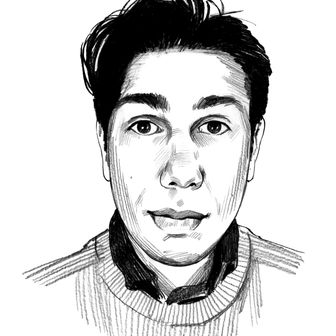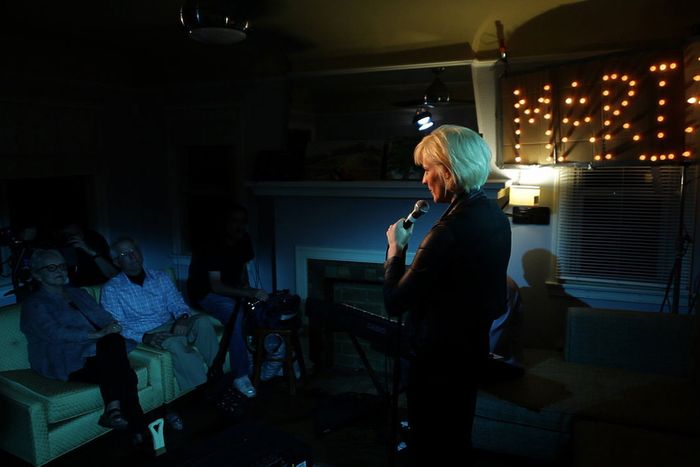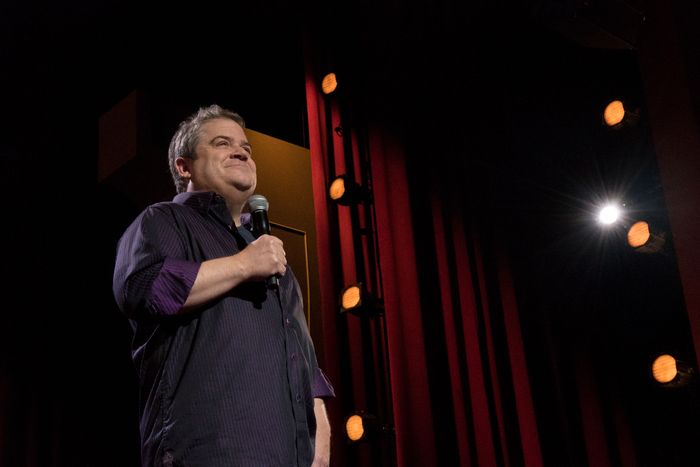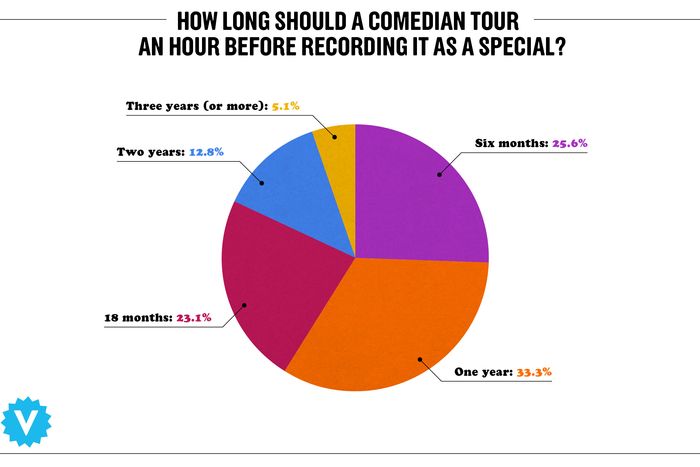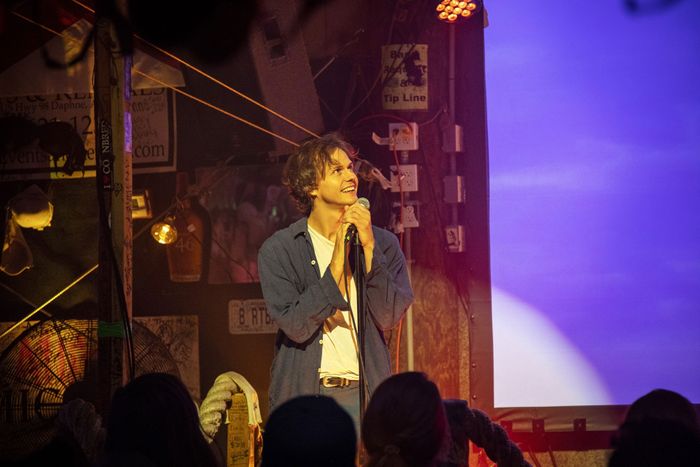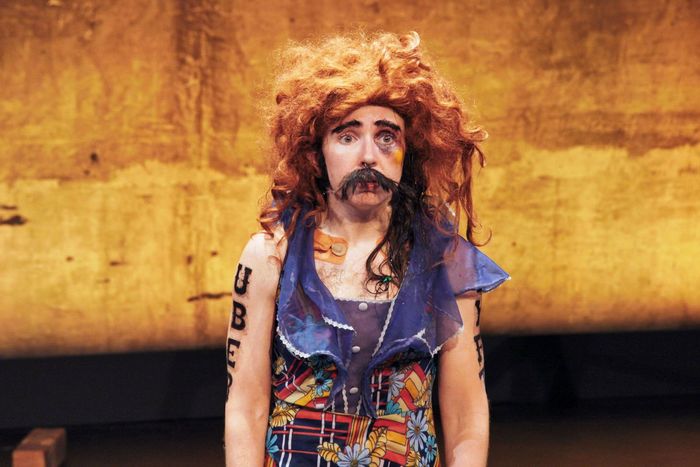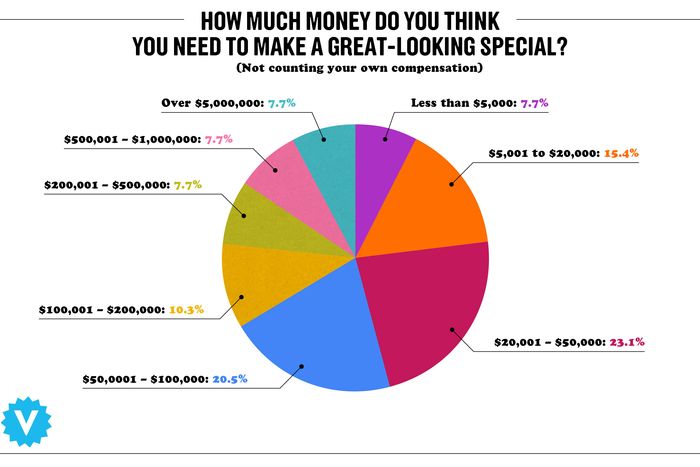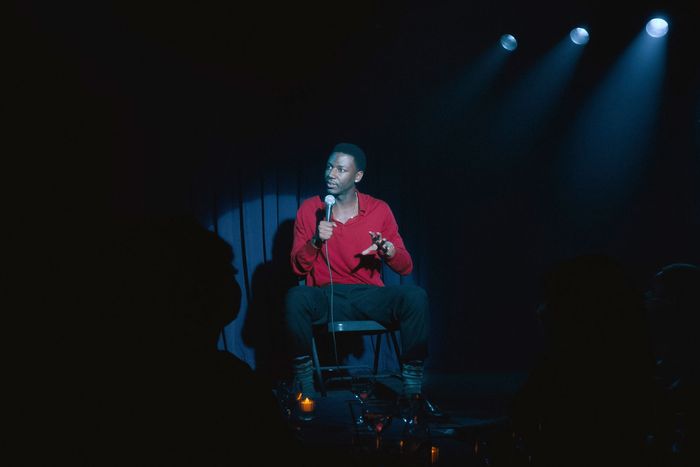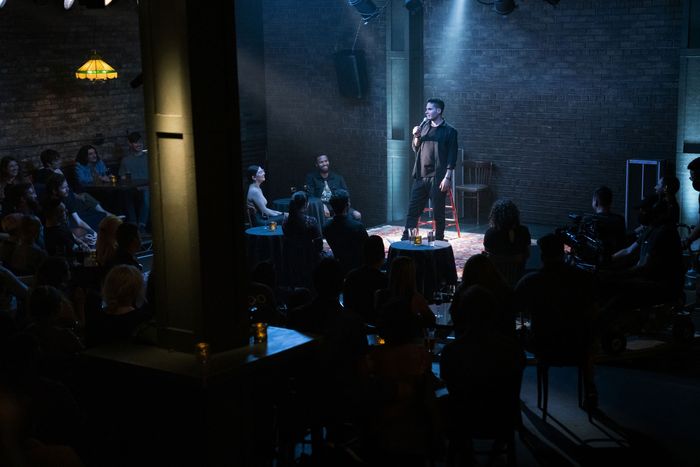
What makes a comedy special special? Vulture spent a week trying to get to the bottom of this question. But what do the people who make specials think of the form? We asked 39 comedians to participate in a questionnaire about comedy specials — to share their opinions on tropes they’d like to see eradicated, the length of time it’s acceptable for a special to go without laughs, what they’d like to change about their previously released specials in retrospect, and more. The responses are full of insights, with comedians speaking to how much they love Maria Bamford, how important it is to avoid wearing sparkly clothing at a taping, and how Los Angeles is far and away the worst city for filming a special.
What Makes Someone Else’s Special Special
Is there a special that changed the way you think of specials and what they can do?
Further proof that Bamford — whose work was cited by six comedians in their responses — is an unrivaled genius.
“I loved Adam Sandler’s 100% Fresh and how it showed the artifice of putting work together. That was absolutely my jam.” —Aisling Bea
“I Coulda Been Your Cellmate!, by Mo’Nique. She shot it in a women’s prison and spent about 20 minutes of it on documentary footage, interviewing some of the audience members (outside the show) about their experiences. It’s rare for a special to tell you such a complete story — not just about who the comedian is but who the audience is and why they’re laughing. Not to mention it’s one of the most hyped crowds I’ve ever seen for a taped special. The energy is just … hard to describe. It really felt like a once-in-a-lifetime show, which is hard to pull off.” —Emily Heller
“Natalie Palamides’s Nate was a good reminder that the weirdest artsy show can succeed when filmed. When I saw it live, I had no idea if it would work as a special, and it did. And when I showed my parents, they asked me how that could be considered art, and we debated Nate’s artistic value for a few hours. That hasn’t happened with any other Netflix special I have ever showed anyone.” —Kevin James Doyle
“Jerrod Carmichael’s Rothaniel was fascinating to me in its rawness and in its artifice. I don’t know for sure, but I imagine all the questions the audience asked were scripted and set up. There’s no audience in the world that is that on top of it, actively listening, and able to ask the precise, therapeutic questions to move the story forward. And yet the result didn’t feel scripted at all.” —DeAnne Smith
“Julio Torres’s My Favorite Shapes, like Fred Armisen’s special [Standup for Drummers], sort of showed you can geek out about just a certain thing and have that be a special, or Tig’s latest fully animated special literally playing out her bits. It’s cool that specials can be approached in whatever style serves your personality and sense of humor.” —Atsuko Okatsuka
“Chelsea Peretti really did some cool, bold shit with One of the Greats. I think it was ahead of its time in the way it broke the traditional special rules. And it definitely made me feel like we need to feel more free to play with all facets of the form.” —Langston Kerman
“Maria Bamford’s The Special Special Special! Maria shot it in her house with her parents as the audience. She’s the most original we have working, and I look up to everything she’s accomplished. Not to mention performing an hour in front of my parents would be a living nightmare. I don’t know how she did it.” —Joyelle Nicole Johnson
“Maria Bamford is an actual risk-taker. The rest of us are frauds.” —Kyle Kinane
Other specials cited: George Carlin’s Playin’ With Your Head, Kristen Schaal’s Live at the Fillmore, Zach Galifianakis’s Live at the Purple Onion, Drew Michael’s Drew Michael, Lil Rel Howery’s Live in Crenshaw, Eddie Murphy’s Raw, Katt Williams’s It’s Pimpin’ Pimpin’, Whitmer Thomas’s The Golden One, Bo Burnham’s Inside, Doug Stanhope’s Beer Hall Putsch, Carmichael’s 8, Chris Rock’s Tamborine, Hannah Gadsby’s Nanette, Gary Gulman’s The Great Depresh, Earthquake’s Legendary, Tig Notaro’s Knock Knock, It’s Tig Notaro, and Moses Storm’s Trash White.
What are the best opening/closing shots from recent specials?
There may be some recency bias at play here, but nine different comedians highlighted the breathtaking beauty of the snowy, jazz-filled walk that Carmichael took to and from New York’s Blue Note Jazz Club in Rothaniel. Megan Gailey praised it for being “really simple and beautiful,” and Howery called it “so brilliant.” Others praised the artistic flourishes and grand reveals their peers use to bookend their specials. “I still can’t stop thinking about Chelsea Peretti’s special opening where she rides up on a motorcycle,” said Aparna Nancherla, regarding 2014’s One of the Greats. Michael’s closing reveal of the show within the show on Red Blue Green was incredible, in my opinion,” said Gastor Almonte. Other specials cited by comedians include Ramy Youssef’s Feelings, Howery’s Live in Crenshaw, and Aziz Ansari’s Nightclub Comedian.
What does a special need to accomplish for it to be considered an artistic success?
“As much as this is a changing landscape, the singular goal remains,” wrote Kerman. He and 13 other comedians, from Lil Rel Howery to Brooks Wheelan, expressed some version of this sentiment: That good jokes and laughter are still the most applicable barometers by which to judge the success of a comedy special.
For others, the question is not up to anyone else to decide on but the performers themselves. “It’s a metric that the artist knows, even if they won’t admit it to themselves,” explained Patton Oswalt. Whether that means “the audience goes through some kind of trauma with you and they come out the other side having really felt something,” wrote Tom Thakkar, or that “you told jokes that you felt proud to tell in your special,” the definition varies.
Niles Abston spoke about marrying the content of a special to its overall aesthetic, and River Butcher talked about creating something that feels like “a band playing rather than a practiced hour of stand-up.” Marina Franklin wrote that it’s about “capturing the Zeitgeist that is in the air and lasting for decades.” But for Johnson, it’s pretty simple: “Just doing it makes it an artistic success.”
The Building Blocks of a Special
Which do you think is the best city/venue for filming a special? And the worst city/venue?
There is no right place to film a special. But there is a wrong place. Ten out of 39 comedians agree to avoid Los Angeles. As Howery put it, “It’s too Hollywood.”
“The best venue is a large black-box theater, and the worst venue is a cabaret space. Black box creates a great space to pack the energy, whereas the cabaret space dissipates the energy, with audience members separated by tables and sipping wine.” —Natalie Palamides
“At this point, specials seem like they’re best when they’re filmed somewhere that actually matters to the comic. Whitmer Thomas filming his special in that weird-ass club in Alabama was so cool and should inspire all of us to find spaces that are as interesting as the dick jokes.” —Langston Kerman
“It depends on where you’re at in your career, but too big of a venue is bad for a special, in my opinion. I loved Rory Scovel’s special from Atlanta and Eddie Pepitone’s from Dynasty Typewriter because the venues were small enough to feel like something magical was happening in that room and was captured.” —Tom Thakkar
“Best: Brooklyn, at the Bell House! Worst? I once did a college in Kirksville, Missouri, and made a joke about it being a sundown town; the town has a damn sepia filter. Suffice it to say, I wouldn’t want to film a special in any sundown towns.” —Joyelle Nicole Johnson
“It’s a tie for me. The Paramount Theatre in Denver and the Pabst Theater in Milwaukee are my favorites. I don’t know the worst, thank God.” —Kathleen Madigan
“I think Chicago has a history of having really great audiences. They aren’t jaded by showbiz, which means there’s likely to be real excitement in the air because they get to see something special.” —Joe Kwaczala
What should (and shouldn’t) a comedian wear during a comedy special?
“It’s key that the comic has worn the outfit before. Or looks like they have. Even just one time.” —Ismael Loutfi
“Don’t make it sparkly or shiny. Sparkly/shiny shit is distracting. It catches the light too much. You want sparkly if you’re playing a big venue and want to make sure you can be seen. But for TV, sparkles are terrible.” —Kurt Braunohler
“Don’t wear something ‘to look nice’ if it’s not how you would look nice if you went somewhere. Wear shoes you can move in, and have some fun with it — have some style, and don’t worry that it might look dated another time. It will! Especially the safe ‘This-doesn’t-look-dated jeans and a shirt’ option. It still does.” —Jen Kirkman
“Best advice I received was from the great Aida Rodriguez: ‘Wear comfortable shoes.’ So I chose a bomb-ass bootie with a manageable heel. Being comfortable onstage is a necessity.” —Joyelle Nicole Johnson
“I am mostly horrified by the outfits worn in specials. Admittedly, comedians are not known for their fashion sense, but when I see a special, I am hoping even the worst dressers will have hired a stylist. So then I am sitting there trying to enjoy myself but instead wondering, Was there a stylist? Do they hate the comedian?, or Where do you even buy shoes this ugly?, or Do they have no friends? So I guess my answer is, top to bottom, it all matters. The hair and makeup matters. Matching shades of black matters. And I don’t even think people need to dress ‘nice.’ Dress to match the aesthetic of your act and what you’re saying. And how you dress for late night matters, too. For the love of God, please try and get professional help!” —Megan Gailey
What is the most overused aesthetic trope in stand-up specials?
It seemed like comedy had left behind the brick wall forever, but then comics started shooting specials at the Comedy Cellar in New York. From sketches at the top of their specials to footage of comedians walking from backstage, here are the clichés comedians most want to eliminate.
“Stools — most people never sit on them. A carpet on the stage. A sketch in the beginning. The living-room scene or your name in big block letters as well as a bare stage with subpar spotlight. Sweeping camera moves on a dolly or a jib. Shooting in black and white to me just says ‘I’m trying to be artistic’ without actually doing it. I hate the big ‘We’re doing this because it’s on-camera’ ovations comics get when they walk out onstage in a special. I fucking hate sketches of any sort. I hate when comics use visual media (putting up pictures on a screen, etc.). Anything that turns a stand-up special into a documentary and breaks up the set. And comedians pandering to the city they’re filming in. I don’t really like dizzy, handheld close-ups of the comedians when they’re in between jokes; it neither mimics the feeling of being in the audience nor gives you a special vantage point you really want. It usually feels sweaty and disorienting to me. Cutting to an audience shot of a person who best encompasses the perceived demographic of the current joke being delivered: Is the comic talking about Chinese food? Better cut to the Asian guy laughing so everyone knows it’s okay! Comedy should have four shots max: tight, wide, medium, and maybe one from behind the comic for edits. Otherwise, the director/team is just jacking off. Who watches comedy while slowly walking to their left or right? Folks can follow a joke without a sudden cut to a different angle for the punch line.”
Who is a director you’d love to see direct a comedy special?
Sean Baker, Damien Chazelle, the Daniels, Ava DuVernay, Nate Edwards, Tim Heidecker, Abbi Jacobson, Shaka King, Yorgos Lanthimos, Ali LeRoi, George Lucas, David Lynch, Hiro Murai, Kelly Park, Yanillys Perez, Amy Poehler, Marcus Russell Price, Boots Riley, the Safdie brothers, Martin Scorsese, M. Night Shyamalan, Tasha Smith, Steven Soderbergh, Quentin Tarantino, Denis Villeneuve, Rudy Valdez, David Wain, Taika Waititi, Edgar Wright, S. Craig Zahler, and “whoever made The Arrival of a Train in the 1800s.” (Have some respect for the Lumière brothers!)
Thoughts on the Audience
How a comedian thinks about the audience at their taping depends a lot on what mood they want their special to capture. Gabriel Iglesias recently taped a Netflix special for 56,000 people at Dodger Stadium; Bamford taped a special for just her parents in her living room a decade ago. Everything else — from audience-reaction shots to stretches without laughter — follows from this choice. Still, a majority of the comedians we surveyed (89.7 percent) said 100 to 1,000 people is the sweet spot for a special’s audience size, and over half of the comedians we surveyed (61.6 percent) believe laughless chunks of specials should not surpass two minutes.
What are your thoughts on crowd work in specials?
Whether comedians like seeing crowd work in specials depends on whether that energy translates onscreen. “It has to be able to hit the people watching on their couches or on their phones, or edit it out,” wrote Abston. “It’s a bit of a high-wire act,” wrote Oswalt. “You’re burning film and money on something that might not work. But the payoff is immense if it connects.” Bea made a case for crowd work as a technique that makes a special feel alive: “It’s very big in the U.K. and Ireland. I love the idea that a show is a contract between you and the audience, and we all have to bring our attention to the moment.” “I think comedians should live in the moment more on the whole,” wrote Yedoye Travis. “Both refusing to do crowd work in a special and exclusively doing it feel very egoistic to me.”
Comedians Reflect on Their Own Specials
Material aside, which creative choices did you make while filming your special that you’re most proud of?
The road to making a comedy special is paved with thousands of little choices. Here, the decisions comedians look back on most fondly:
“The ability to bring everything I have worked so hard on back to my hometown of Chicago. All the elements were there: family, my love of house music, and a general feeling of home.” —Marina Franklin
“Telling production for Loose in Chicago, ‘I picked the Cabaret Metro in Chicago because it’s the Cabaret Metro in Chicago. So don’t fuck with the look of it.’ I picked the 40 Watt in Athens for I Liked His Old Stuff, and when I got there, a design team had constructed a whole fake background. I felt like, Well, why let me pick a location if you’re going to transform it into whatever you want anyway?” —Kyle Kinane
“That I had four professional dancers dress up in beaver suits and do a tightly choreographed routine as I grabbed on to a rope and ascended into the rafters at the end of my show.” —Kurt Braunohler
“Incorporating multimedia despite the technical difficulties during the taping.” —Aparna Nancherla
“In my second Netflix special, there’s a mini-documentary that accompanies my stand-up that really contextualizes my stories and will introduce a wider audience to who I am as a comedian.” —David A. Arnold
“Doing the first three myself: choosing venues, selling tickets, promoting. I learned every aspect of producing a special, so when I did my half-hour with Netflix, I knew exactly what I wanted and what I didn’t. I was fully involved in the editing of my special.” —Gina Yashere
“We were lucky enough to get to use the song ‘Keep on Livin’,’ by Le Tigre, for the opening credits. Kathleen Hanna saw me do the hour a couple weeks before we shot and gave the okay after that.” —Emily Heller
“Since I only have done a Comedy Central half-hour, my creative choices so far have been limited. But I guess I’d say going with a name I knew I was going to change.” —River Butcher
If you had to reshoot one of your own specials with the same material, what would you change?
“I’d give the network less material to choose from. For my Comedy Central half-hour, I probably did 35-plus minutes, and when they cut it down to 21, it lost some of the life and flow that lived in the original set. If I shot it again, I’d do a tight 22 and throw in one joke I didn’t care about for them to cut.” —Langston Kerman
“I wouldn’t put it on cable. Comedy shouldn’t be interrupted by commercials. It changes the flow and takes you out of the experience.” —Sarah Tiana
“The stage setup, the lighting, the city shot in, the setup of the venue, my outfit.” —Cocoa Brown
“I wouldn’t wear a hoodie. It really made me look like an open-mic comic.” —Sean O’Connor
“For some reason, Comedy Central decided to put a wheat field and a silo as my background in one, which was so bizarre it made me laugh. But I’d change it to the St. Louis Arch or something less Little House on the Prairie and more of a Midwest city.” —Kathleen Madigan
“If I could redo my last special, I’d have asked for less makeup. I think I look a little weird.” —Tom Thakkar
What do you think of the way specials are marketed, and would you change anything about it?
“I don’t like that they’re marketed like music concerts. It sets up a warped expectation for the viewer. Concerts are great, but they’re spectacles. Stand-up specials are also great, but they’re conversations. Once you add noise and frantic motion to them, you’ve untethered yourself from thought and connection. Very frustrating.” —Patton Oswalt
“Networks don’t know how to anymore. Stop with the hack-y trailers with pieces of the comedian’s jokes in between corny music.” —Niles Abston
“I think there are so many specials that the comedian is almost solely responsible for marketing through social media and podcasting. Billboards are a vanity thing. Late-night-show appearances don’t do anything. I don’t like it, but I also don’t know what else could be done.” —Anthony Jeselnik
“Give me one billboard in my home city so I can take a photo in front of it. Then use the other thousands of dollars to get a good stunt going. How about I travel city to city on a Bird scooter doing pop-up comedy sets at old-folks’ homes?” —Kurt Braunohler
“I would change Netflix insisting that my billboards and marketing had to have a catchphrase because they feared people wouldn’t know it was a comedy special, even though it said ‘comedy special.’ They didn’t do this to any of the male comics.” —Jen Kirkman
“Chop it up and put it out for free. Specials are just commercials for ticket sales — for me, anyway. I’m not trying to be showbiz famous. I want to be a successful comedian. I want to perform stand-up to as many people as I can. If butchering an hour for clips gets more people to find me, then slice and dice that shit and get it out there.” —Kyle Kinane
What do you wish more people understood about planning and producing a special?
Specials don’t begin with long disclaimers about all the work that goes into them. But if they did, these are the types of qualifiers they might feature.
“If you’re not shooting and producing it yourself, you have less say-so as to the creative choices than people might think you do.” —Aparna Nancherla
“That stand up-comedy on TV can only be so good. It’s a performance style that’s best experienced in person. Every special you watch on TV, the people who were at the taping had more fun or were more engaged than your butt at home on the sofa.” —Doug Benson
“That a lot of comedians shoot two shows back-to-back and the turnaround for my messy-ass shows should be their own special. I’d be regluing hair to my chest real fast or getting eggshell out of my ass real fast while a group of solid friends are blow-drying my costume. During my turnaround for my Amazon U.K. special, we put blow-dryers in my shoes, and they shrunk so badly that my feet could barely fit and the soles of the shoes were peeling off. The heel of my shoe fell off mid-performance, and as a result, I fell straight on my ass. It was great.” —Natalie Palamides
“Releasing a project can really be a two-year project. You write and hone it for a year, tour it for six months, tape it, and then you edit it for three months after that. Your publicist starts reaching out to press months before the release to time the reviews and articles to the release. While they do that, you spend the three months leading up to it doing any blog/vlog interview you can. The three months after it, you’re doing radio and podcast interviews to promote it while blasting social media. And you start performing again, but keep in mind you should be doing new stuff because you’ve just released all your working material of the past year, so that’s burned.” —Gastor Almonte
Questionnaire respondents: Niles Abston, Gastor Almonte, David A. Arnold, Aisling Bea, Doug Benson, Kurt Braunohler, Cocoa Brown, Sophie Buddle, River Butcher, Kevin James Doyle, Bil Dwyer, Marina Franklin, Ron Funches, Megan Gailey, Emily Heller, Lil Rel Howery, Anthony Jeselnik, Joyelle Nicole Johnson, Danny Jolles, Langston Kerman, Kyle Kinane, Jen Kirkman, Joe Kwaczala, Ismael Loutfi, Kathleen Madigan, Dave Merheje, Aparna Nancherla, Sean O’Connor, Atsuko Okatsuka, Patton Oswalt, Rick Overton, Natalie Palamides, Erica Rhodes, DeAnne Smith, Tom Thakkar, Sarah Tiana, Yedoye Travis, Brooks Wheelan, and Gina Yashere.
More From This Series
- Michael Bonfiglio Wants to Tell You a Story
- I Sat Front Row at Maria Bamford’s Comedy-Special Experiment
- The Standard-Setting Beauty of Live in Crenshaw


